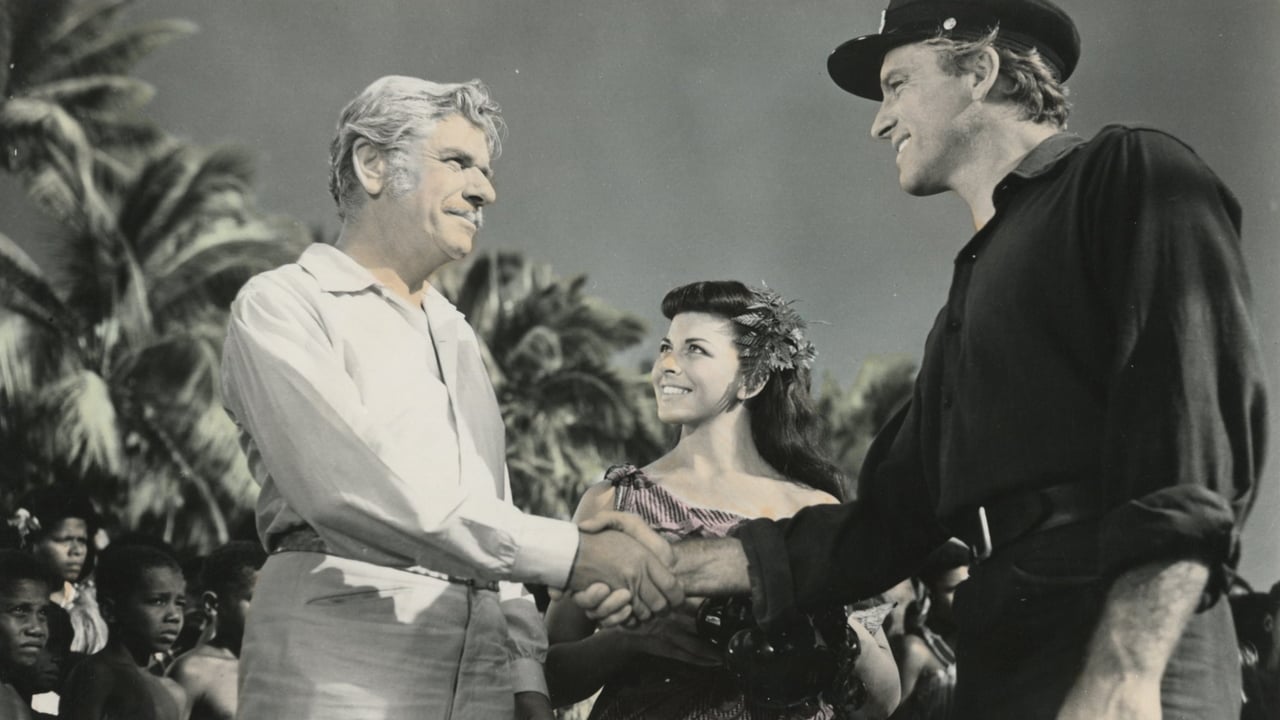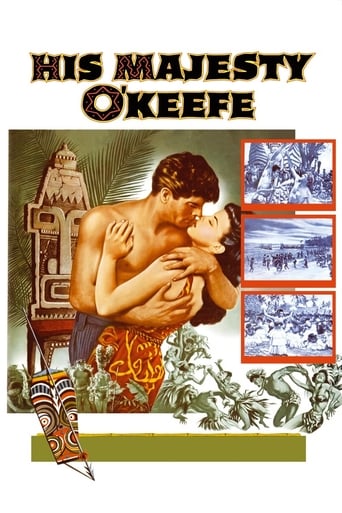Platicsco
Good story, Not enough for a whole film
Merolliv
I really wanted to like this movie. I feel terribly cynical trashing it, and that's why I'm giving it a middling 5. Actually, I'm giving it a 5 because there were some superb performances.
filippaberry84
I think this is a new genre that they're all sort of working their way through it and haven't got all the kinks worked out yet but it's a genre that works for me.
Roy Hart
If you're interested in the topic at hand, you should just watch it and judge yourself because the reviews have gone very biased by people that didn't even watch it and just hate (or love) the creator. I liked it, it was well written, narrated, and directed and it was about a topic that interests me.
James Hitchcock
Captain David O'Keefe was a real-life person, a 19th century Irish-born adventurer from Savannah, Georgia, who made his fortune in the copra trade on the South Pacific island of Yap. This film is a fictionalised version of his life-story, and as one might expect takes a few liberties with history. In the film O'Keefe becomes king of Yap and defends his people against the incursions of aggressive German colonisers. In reality, when O'Keefe arrived on the island in 1871 it was a Spanish colony and the newly-united German Empire had no interest in acquiring colonies in the South Pacific or anywhere else. Yap did not become German until 1899, well after the date at which the film is set. This change was possibly made because in 1954, only nine years after the end of the war, American audiences would have been more accustomed to seeing Germans than Spaniards as cinematic villains. The film does, however, provide one "good German" in the shape of O'Keefe's friend Alfred Tetens, another real-life person. O'Keefe did indeed marry a local girl as shown here, but the film tactfully omits the fact that their marriage was invalid because he already had a wife in Savannah. The Production Code officially forbade the depiction of racially mixed marriages or romances, but by the fifties there seemed to be an unofficial relaxation of this rule in force. Relationships between white men and non-white women could be shown provided (a) the girl was described as being of mixed race and (b) she was played by a white actress. This rule was applied in "Showboat" and "Love is a Many-Splendoured Thing", and is also applied here. O'Keefe's sweetheart Dalabo, supposedly of mixed European and Micronesian descent, is played by the Derbyshire-born Joan Rice. Dalabo has a rival for O'Keefe's affections, but the said rival, being pure- blooded Yapese, has to lose out. Rice, although undoubtedly decorative to look at, is never really convincing as a native of the South Seas, or for that matter of any part of the world further south than Derbyshire. Burt Lancaster, however, makes an agreeable hero, and receives good support from André Morell as Tetens. Later in his career Lancaster could be a very intense actor, often appearing in dramas with a serious social, political or philosophical purpose, but in his action films of the early fifties his style of acting was generally much more relaxed, and so it is here. Many film-makers of the early days of the cinema were reluctant to venture too far away from a Hollywood studio, even when their films were ostensibly set in some exotic part of the globe. This attitude still prevailed in some quarters during the fifties; for example "Brigadoon", also made in 1954, had to be shot on MGM's sound stage, against a vast painted backdrop of Scottish-style scenery, because Dore Schary was reluctant to stump up the cost of transporting cast and crew all the way to Scotland, or even to some part of America that looked like Scotland. In other quarters, however, attitudes were changing as the studios began to realise that local colour and authentic scenery could be useful weapons in their battle against the new enemy, television. "His Majesty O'Keefe" is a case in point, as much of the film was actually shot on location in the South Pacific. This doubtless increased the budget, but I think that the decision was the right one, as the result was a colourful, visually attractive film. Byron Haskin is unlikely to feature very highly on any list of Hollywood's great auteurs, but he was capable of producing some very decent and enjoyable adventure films (his 1953 version of "The War of the Worlds" is probably the best known) and this is another in that category. 7/10
Spikeopath
His Majesty O'Keefe is directed by Byron Haskin and adapted to the screen by Borden Chase & James Hill from the novel written by Lawrence Klingman & Gerald Green. It stars Burt Lancaster, Joan Rice, Andre Morell and Abraham Sofaer. Music is by Robert Farnon and Technicolor photography by Otto Heller.Plot finds Lancaster as Captain David O'Keefe, who after a mutiny is tossed overboard in the South Pacific. Making his way to Yap Island, O'Keefe is pleased to see the money making potential by harvesting copra from the mass coconut growth on the island. However, the natives aren't exactly thrilled by his intentions and there's also some serious German businessmen interested in the island as well. Too many cooks spoil the broth and this once peaceful little island is soon to become a hotbed of greed and division.It's all very muscular and pretty (actually filmed on location in Fiji), led by a super tanned, white toothy grinned Lancaster, film has a very decent theme at its core, but sadly this mostly get lost in the confusing mixture. Picture never quite settles into being one cohesive whole, at times a wannabe swashbuckling adventure propelled by a South Seas love story, at others an observation of capitalism corrupting the beautiful untapped paradise's of the world. The pace is stop/start, with Haskin (Treasure Island) struggling manfully to make the various strands of the screenplay work, and cast are effective enough in just about retaining viewing Interest.Worth it for Lancaster fans, and for fans of great choreography and attractive scenery. But it remains a hit and miss affair, it takes an age to make its point but survives ignominy on account of the unusual flavours in the mix. 5/10
MartinHafer
"His Majesty O'Keefe" is a pleasant adventure film, but one that it far from Burt Lancaster's best. For fans of the charismatic actor, it's well worth seeing but for the rest it is imminently forgettable.The film is set around the now the middle of the 19th century in the South Pacific. After a mutiny, the Captain (Lancaster) is cast adrift and eventually finds his way to the Fijian island of Yap. Here he meets a nice German guy who has been working there for 20 years trying to get the locals to work to produce copra (a dried coconut product), but without much success. However, the newly arrived Captain O'Keefe is a natural for this sort of work and is able to eventually figure out how to get the islanders to produce tons of the stuff--and finds himself as their new king! The problem is that there are greedy forces out there that want this crop and are willing to take it if necessary--and His Majesty O'Keefe needs to mobilize his people for this onslaught. In between there is a romance and lots of other happenings.Pleasant. That's my feeling about the film. It's not super-exciting nor extraordinary, but given Lancaster's nice screen presence, it's easy-going and of some interest.
artzau
Aside from some good old studio stand-bys, like Benson Fong and Philip Ahn (A Korean usually cast as some other Asian), this film has few of the faces that hung around the screens of Hollywood. But, Lancaster teamed up with the lovely Joan Rice from the UK to give us a wonderful tale of adventure in the South Seas. This time, it takes us to the Solomons to the island of Yap, who worship the stone Fey, spirits who reside in stone wheels cut and transported nearly a thousand miles. O'Keefe winds up becoming their king but with profit in mind. He wants to exploit the copra market but the Yap Islanders won't work. So, he hits on the plan to bring their Fey back and this is the beginning. The Solomons were part of the old German trust Islands and there actually was a man named O'Keefe who slipped in by marrying a local girl. But, the Germans, unlike in the movie, eventually kicked him out until they were kicked out after the first world war and then the Island went to the Japanese who were kicked out after the second world war and then...well, you get the idea. I loved this film when I saw it as a kid. No, it's far from perfect but it is a charming story with lots of action and Burt was at his best. But, those beautiful green eyes of Joan Rice were a delight as well. It's too bad we saw so little of her afterwards. Also, there's a lovely song from this film, based in part on Rachmaninov's rhapsody, called Sweet Emerald Isle. Check it out.

